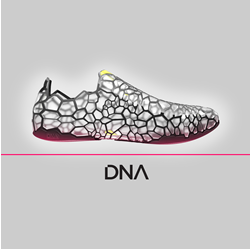 Seattle based product development firm, Pensar Development, has created a shoe concept that demonstrates how 3D printing will impact the future of the retail experience, point-of-sale manufacturing, and the product design process.
Seattle based product development firm, Pensar Development, has created a shoe concept that demonstrates how 3D printing will impact the future of the retail experience, point-of-sale manufacturing, and the product design process.
Pensars DNA shoe concept uses footwear to examine the opportunities around point of sale manufacturing and ergonomic/biomechanical tailoring. Typically, the athletic footwear market relies on set sizing to accommodate the most common foot shapes and movement styles. For many people, the average fit does not equal the best fit. To create a more user centric design, footwear needs to be based on each customers feet.
The first step is to acquire the data that an individual’s shoes will be based on. Each foot is three dimensionally scanned. Then the customer puts on a pair of special sensor shoes and goes for a test run or walk. The sensors track their movement (e.g., footfall, pronation, balance, etc.), and combined with the scan create a usable database to build the new shoes around.
Algorithms are used to translate the data into form and the shoes start to come together. Next, the customer is able to customize the materials, colors and textures of their shoe, or they can save a shoe design in advance that can be combined with their foot data when they get to the store. The design then goes to print, and as they shop the 3D printer creates their shoes.
Costly tooling and expensive skilled labor has prevented the mass market from owning custom-tailored products. The goal of the DNA concept is to illustrate a path where 3D printing can enable customers to engage in the design process and create a personalized product. Automating the process through algorithm-driven design and 3D printing will make it economically viable to a much larger audience.
While there are obvious benefits to consumers, there are positive impacts to retailers as well. First, by creating products on demand, retailers will be able to offer limitless design updates and customization. Second, the ability to have your shoes custom fit will draw online customers back into stores. Third, while raw materials will need to be stocked, inventory of pre-built products will be greatly reduced, giving the retailer more flexibility and less overstock of undesired product.
Pensars DNA shoe explores how 3D printing will evolve the retail experience for customers and change the way products are designed and manufactured. Before this concept can become a reality, there are advancements that need to take place in 3D printing technology. For example, the materials currently available dont offer the durability or softness necessary for wearing every day or for athletic use. Further study is also required to ensure the materials are biocompatible and safe for consumers. Today, the cost and time it takes to print a pair of shoes are both too high.
However, the 3D printing industry is evolving quickly, and while material challenges may prohibit immediate implementation, user-driven rapid manufacturing will be realized in the near future.















